Exploring How Different Your Cat’s Senses Are than Yours
Estimated 0 min read
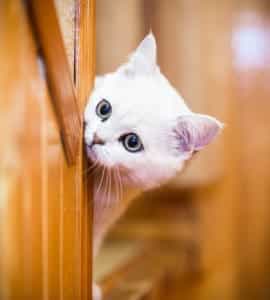
Curious cat’s senses
Ever watched your cat suddenly bolt across the room chasing something invisible, or witnessed them stare intently at a seemingly empty corner? These quirky behaviors aren’t just entertaining – they’re windows into how your feline friend experiences the world around them. While we share our homes with these fascinating creatures, their perception of reality differs remarkably from our own, shaped by cat’s senses that have evolved over thousands of years of feline evolution.
Understanding how your cat experiences the world isn’t just about satisfying curiosity – it’s about becoming a better pet parent. When you know what makes your cat tick, you can create an environment that helps them thrive and spot potential issues before they become problems. Let’s explore the extraordinary sensory world of cats and discover why they behave in ways that might seem mysterious to us.
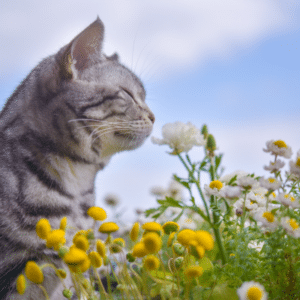
Scent plays a key role in cat communication
Your Cat’s Sense of Smell
Your cat’s adorable button nose holds remarkable power, functioning about 40 times more effectively than a human’s sense of smell. This heightened olfactory ability stems from approximately 200 million odor-sensitive cells packed into their nasal cavity, compared to only five million in humans. Cats rely on this supercharged sense of smell for essential daily activities, from determining if food has spoiled to tracking potential prey and finding their way home.
Perhaps most fascinating is how cats possess a secondary scent detection system called the vomeronasal organ, located on the roof of their mouth. This specialized organ allows cats to detect chemical signatures and pheromones that aren’t airborne, giving them an additional layer of sensory information about their environment. When you notice your cat appearing to sniff with their mouth slightly open, they’re actually engaging this remarkable organ to gather even more detailed scent information.
Scent also plays a crucial role in feline communication and territory marking. When your cat rubs against furniture, doorways, or even your legs, they’re leaving behind their unique scent signature. This behavior serves multiple purposes, marking safe spaces within their territory and sending clear messages to other cats about boundaries. Your feline friend uses these scent markers like we might use street signs, creating an invisible map of their domain.
Interestingly, while humans primarily recognize each other through visual cues, cats identify their favorite people primarily through scent. Your unique odor signature becomes your cat’s primary way of recognizing you, even before they process your visual appearance. This explains why cats often seem more interested in sniffing your shoes or clothes than looking at your face when you return home.
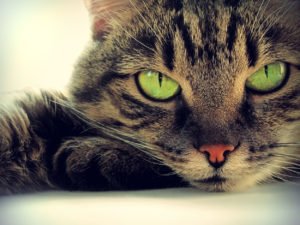
Cat’s color vision is very different from ours
Your Cat’s Sense of Sight
Cats possess an extraordinary visual system that sets them apart from both humans and many other animals in the animal kingdom. Their specialized eyes contain a remarkable feature called the tapetum lucidum, a reflective membrane that magnifies incoming light and creates that distinctive blue or greenish glint you notice in their eyes at night. This unique adaptation allows cats to see up to six to eight times better than humans in dim lighting conditions.
While cats don’t actually see in complete darkness as some might believe, their eyes are specifically designed to excel in low-light conditions like dawn and dusk. The secret lies in their high concentration of light-sensitive cells called rods within their retinas. These specialized photoreceptors work overtime to absorb available light, making cats especially adept at detecting movement in near-darkness, a skill that served their ancestors well as hunters.
Cat Color vision
Color perception in the feline world differs significantly from human vision, though contrary to popular belief, cats can indeed see some colors. Their retinas contain fewer color-sensitive receptors than human eyes, limiting their ability to distinguish colors in the red-green spectrum. Cats experience the world similarly to a person with red-green colorblindness, seeing blues and yellows clearly while other colors take on more muted, grayish tones.
When it comes to distance vision, cats operate best in their middle-vision range, approximately 20 feet away, where objects appear clearest and most focused. Beyond their sharp middle-distance vision, cats enjoy an impressive peripheral view of about 200 degrees, compared to the human range of 180 degrees. This expanded field of vision results from the strategic positioning and shape of their eyes, providing an evolutionary advantage for spotting both prey and potential threats.
Cats also possess highly specialized pupils that can dilate dramatically, allowing them to capture a panoramic view of their surroundings. These adjustable pupils work in conjunction with their other visual adaptations to create a visual experience perfectly suited for a predator. Even with their impressive visual capabilities, cats have a small blind spot directly beneath their chin, reminding us that even the most refined senses have their limitations.
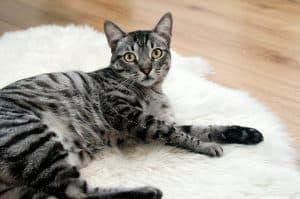
Cats hearing is primitively based on hunting
Your Cat’s Sense of Hearing
Your cat’s large, triangle-shaped ears serve as sophisticated sound-detection instruments, capable of hearing frequencies far beyond human capabilities. These remarkable organs can detect sounds up to 64,000 Hz, while human hearing typically stops at around 20,000 Hz. This enhanced hearing ability even surpasses that of dogs, making cats among the most acoustically gifted creatures in our homes.
The unique anatomy of feline ears contributes significantly to their superior hearing capabilities. Their distinctive cone-shaped outer ears act as natural amplifiers, channeling sound waves into the middle and inner ear with remarkable precision. These proportionally large ears can rotate independently to pinpoint the exact location of sounds, serving as highly effective direction finders.
Nature designed cats’ hearing system with hunting in mind, particularly focusing on their ability to detect high-pitched sounds. This specialization proves especially useful for tracking typical prey animals like mice and birds, whose vocalizations often occur at higher frequencies. The ability to rotate their ears toward specific sounds helps cats create a detailed acoustic map of their environment.
Cats’ sensitive hearing means they experience our modern world in ways we might never imagine. Common household items, like LCD computer screens or electronic devices, can emit high-pitched frequencies that may prove stressful to our feline companions. What humans perceive as mere background noise might actually register as significant sound to a cat’s sensitive ears.
Deep within the inner ear lies another crucial component of feline sensory perception: the semicircular canals. These fluid-filled structures contribute significantly to cats’ legendary balance and agility. This intricate system allows cats to maintain precise awareness of their body position at all times, enabling their remarkable ability to right themselves when falling.
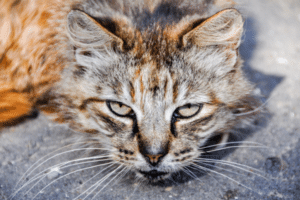
Cat with long whishkers
Your Cat’s Sense of Touch
Your cat experiences touch through a complex network of highly specialized sensory organs spread throughout their body. While they possess nerve endings across their entire form, their whiskers and paw pads stand out as extraordinarily sensitive instruments. These sophisticated touch receptors transform your cat’s body into a living radar system, constantly gathering information about their environment.
Cat Whiskers
Whiskers emerge as one of the most remarkable features of feline touch sensitivity, extending from multiple strategic locations across their body. These specialized sensory tools sprout from their cheeks, above their eyes, near their ears, under their chin, and even along their forelegs. Unlike regular fur, whiskers grow from a deeper skin layer and contain thick, highly sensitive follicles that rival human fingertips in their ability to detect sensation.
Each encounter between your cat’s whiskers and an object delivers vital information directly to their brain. These remarkable sensors detect subtle variations in temperature and texture, helping cats make split-second decisions about their surroundings. The whisker system proves so sensitive that it triggers an automatic protective blink reflex when touched, helping safeguard their eyes from potential injury.

Cat’s have a very sophisticated sensory system
Cat Pads
Your cat’s paw pads function as sophisticated touch sensors, covered in a dense network of nerve receptors that continuously relay information to their brain. This intricate system allows cats to navigate challenging terrain effortlessly and examine objects with remarkable precision. These sensitive pads even enable cats to detect sound vibrations through the ground, adding another layer to their sensory awareness.
The combination of whiskers and sensitive paw pads creates an advanced tactile warning system that helps cats move confidently through their environment. This sophisticated touch network allows them to judge whether they can fit through narrow spaces, detect approaching objects in the dark, and maintain their legendary grace and agility. A cat’s whiskers extend approximately as wide as their body, serving as natural measuring tools for tight spaces.

There’s a reason your kitty is picky about food
Your Cat’s Sense of Taste
When it comes to the five senses, your cat’s sense of taste stands out as surprisingly limited compared to their other heightened abilities. Their tongue contains fewer than 500 taste buds, a stark contrast to the human mouth’s impressive array of roughly 9,000 taste receptors. This biological difference explains why cats often appear remarkably selective about their food choices, relying more heavily on other senses to evaluate their meals.
Unlike humans who enjoy a wide spectrum of flavors, cats experience a more focused range of taste sensations, notably missing the ability to detect sweetness. This peculiarity makes perfect evolutionary sense for these obligate carnivores, who never needed to develop receptors for sweet flavors. Instead, cats evaluate their food primarily through its fat content and texture, explaining why some cats might seem interested in sweet foods despite their inability to taste the sweetness itself.
What cats lack in taste buds, they make up for with their powerful sense of smell, which plays a crucial role in their eating behavior. Their sophisticated olfactory system enhances their dining experience, making a food’s aroma often more important than its actual taste. This connection between smell and taste becomes particularly evident when cats fall ill – those with respiratory infections or lost sense of smell frequently lose interest in eating altogether.
Bitter Taste Buds
Nature equipped cats with one particularly important taste sensitivity: an acute ability to detect bitter flavors. This heightened awareness of bitter tastes serves as a crucial survival mechanism, helping cats avoid potentially toxic substances in their environment. When your cat seems particularly finicky about certain foods, they might be responding to subtle bitter notes that human taste buds would miss entirely.
Understanding your cat’s unique relationship with taste helps explain their sometimes perplexing dietary preferences. Many cats develop strong preferences for both specific flavors and textures, often refusing to eat anything that doesn’t match their established favorites. This selective eating behavior stems from their limited taste capabilities combined with their natural inclination toward predictable routines, making sudden food changes particularly challenging for our feline companions.
Your cat’s incredible senses make them the remarkable companions we know and love. From their superhero-level hearing to their night-vision capabilities, each sense works together to create their unique way of experiencing the world. But with these powerful senses comes the need for special care and attention.
Banixx for Cat Lovers
When your cat faces health challenges that affect their sensory wellbeing – fromear infectionsthat impact their precise hearing to skin irritations that make their sensitive touch receptors uncomfortable – having the right solution matters. That’s whereBanixxcomes in. Our gentle, clinically-proven products are specifically designed to address your cat’s health needs without causing additional stress to their sensitive systems. Whether you’re dealing with ear issues, skin problems, or other pet health concerns, Banixx provides safe, effective relief that respects your cat’s delicate senses.
Ready to give your cat the sensory-smart care they deserve? Explore our range ofpet care solutionsand help your feline friend stay healthy, comfortable, and ready for their next adventure – whether that’schasing invisible mice or a laser,or simply claiming their favoritesunny spot for an afternoon nap.
Sources
https://www.merckvetmanual.com/cat-owners/description-and-physical-characteristics-of-cats/description-and-physical-characteristics-of-cats#Breeds-and-Body-Size_v3208940
vetmed.tamu.edu/news/pet-talk/a-cats-five-senses
https://www.hillspet.com/cat-care/behavior-appearance/cat-senses-explained
cats.com/cat-intelligence
https://penntoday.upenn.edu/news/demystifying-feline-behavior
https://ir.library.oregonstate.edu/downloads/kk91fr19b
https://co4h.colostate.edu/projects/manuals/Cats-WashingtonState-U3.pdf


















